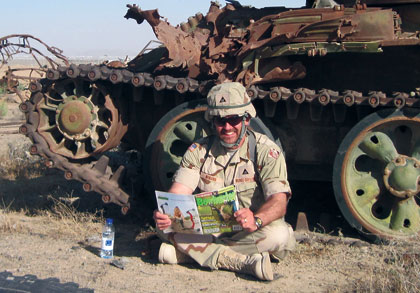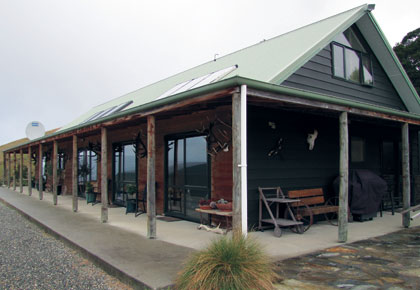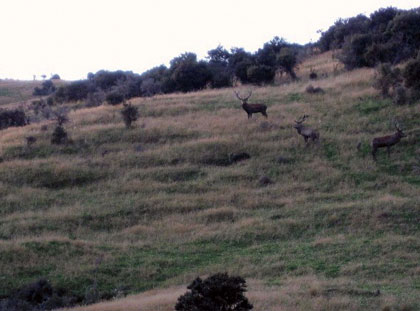May 06, 2011
By C. J. Winand
A little R&R in New Zealand eases the pressures of war-torn Afghanistan.
By C. J. Winand

Advertisement
|
Advertisement
The blowing dust was ever-present, at times blocking out the sun. As it sandblasted my face in the 110-degree heat, I wanted nothing more than to shed my body armor. Afghanistan is hot, real hot.
My job with the U.S. Army Corps of Engineers was to help construct military facilities for the Afghanistan National Army, and that entailed venturing out of the confines of Kandahar Air Field (KAF), known as going "outside the wire." Between trips I had plenty of time to reminisce on how I got there.
I managed to delay my deployment until after the 2009 hunting season, but knowing I was headed to the Middle East in January 2010, I started planning a hunt for my scheduled rest and relaxation (R&R) period. After considerable research, I chose a red stag and fallow deer hunt in New Zealand with Alan and Sue Stewart's Leithen Valley Trophy Hunts.
The biggest question now facing me was how I was going to get my bow to Afghanistan. I simply planned to pack my bow with my military gear, which would allow me to practice shooting at KAF. However, while finalizing my packing list, a Master Sergeant informed me I would not be able to ship my bow.
Because I would be taping this hunt for Bowhunter TV, my only solution was to have our cameraman, Conrad Everts, haul my bow case with him to New Zealand.
After three months of hot, wind-blown sand, my long-awaited R&R finally arrived. Nothing is easy in Afghanistan, but after three days and one missed flight, I finally arrived in Queenstown, New Zealand, where I met Conrad as well as Sue Stewart. Both Conrad and I agreed the two-hour drive from the airport to the lodge reminded us first of the steep mountains of southeast Alaska that then transitioned into the rolling hills of coastal, northern California. Yes, New Zealand is one of the most beautiful places on Earth!
Once at camp, we met Alan Stewart and got situated in a very comfortable room. After traveling halfway around the world, I cautiously opened my bow case and found everything in perfect shape. Picking up my bow was like shaking hands with an old friend.

After spending months in the Afghan desert, I much appreciated Leithen Valley's fine accommodations. |
I shot some arrows and ate some wonderful New Zealand cuisine before Alan went over our plans for the hunt. With over 7,500 acres (11.7 square miles) to hunt, we had plenty of room to spot and stalk our first target -- a fallow deer buck. Leithen Valley restricts the harvest of fallow deer in an effort to produce some world-class bucks, and it's working!
Fallow deer are very aggressive during the rut and they sometimes fight to the death. Because of their territorial nature, Alan has even had some of his sheep killed by fallow deer. With the rut in high gear, I was more than ready to hit the hills.
The topography at Leithen Valley is steep and somewhat challenging. Although in decent shape, I found it a big change from the flat deserts I was used to in Afghanistan. We were always grabbing small trees to help ourselves up the hills. The terrain was steeper than I expected, and even though I knew there wasn't any unexploded ordinance in Leithen Valley, I still found myself looking for land mines and tripwires as we humped it up the mountains.
Our hunt strategy was to listen for the grunts of fallow bucks, and it wasn't long before we heard one directly across the valley from us. The buck kept grunting until we reached the point where we could see him in the thick forest. It's not unusual for bucks to grunt for hours worry-free, because New Zealand has no predators.
As we closed the distance on the buck, the wind suddenly swirled and we were busted. The beautiful black-phase fallow buck was history. Day one ended with just that one close call.

After not shooting for so long and then missing a buck, my confidence was shaken. Making good on this fallow deer, with help from cameraman Conrad Everts (middle) and guide Alan Stewart (right), thoroughly restored my confidence -- and joy. |
Days two and three held only close calls and lessons on just how challenging it is to take a fallow deer with a bow. On the fourth day we awoke to snow-covered mountaintops. It was hard to believe only a week before I'd been sweating like a dog in the Afghan desert.
After two hours of trekking up and down the hills we found a small, level area overlooking a well-used trail. Any shot attempt would be almost straight down. When a good buck walked directly below us I drew and aimed, knowing full well I had to aim low at such an angle. Even though it was only 30 yards, my arrow flew over the buck's shoulder.
Alan just smiled and said, "Let's go! I just heard another one on the far side of the hill."
After 30 minutes of climbing, we had the buck within sight, but we quickly lost him in the thick cover. Then Conrad whispered, "He's over here on the left!"

After Alan spotted these three huge stags, I began what I called a super stalk. |
I grabbed a small tree and pulled myself into a somewhat level shooting position just as the buck stepped out from behind a large beech tree. Although the buck was now quartering toward us, the 35-yard shot was on its way, almost straight uphill! I felt good about the arrow flight but the buck ran off, seemingly untouched.
Alan went to where the buck had been standing. "C.J., I can't find any blood," he said. After marking where I'd shot from, I joined Alan in the search. Within seconds we found a small drop of blood, which led to much more. Just 50 yards away my buck lay pinned between two beech trees. Joy overwhelmed me and restored my confidence. The spotted fallow buck was a good one, and Alan estimated him to be seven years old and around 180 pounds. Fallow deer earned my respect as a very challenging quarry. Now m
y focus would shift to hunting red stags.
Our North American elk were once thought to be a subspecies of the red deer, but recent DNA evidence indicates they are two distinct species. The reason we believed they were related is because red deer and elk will breed and produce fertile hybrids. New research shows elk appear to be more closely related to sika deer than to red deer. From 1851 to 1926, over 220 separate releases of 800-plus red deer occurred in New Zealand. Red deer from Scotland and England adapted very well to New Zealand and were the genesis of that country's present population.
Red deer antlers differ from those of elk. The upper tines on stags form a cup, or crown, in older males. Additionally, unlike the bugling of elk, which carries well in open environments, red deer have a distinctive roar, which resonates better in forested habitats. Trust me, a stag's roar is something you'll never forget.
We hiked up yet another mountain, where Alan quickly spotted three huge stags. That's when we began what I call a super stalk -- controlled slides down muddy embankments while maneuvering through thick, nasty vegetation. As we closed the gap we lost sight of the stags, but then we heard branches snapping. One of the stags was heading directly at us! When he stepped out at 25 yards and stared right at us, I drew my bow but the stag's vitals were blocked by brush. All I could do was watch him turn and run off. We made one more stalk that day but never had a shot opportunity.
After coming so close the day before, my hopes were renewed as we left the truck for a new area. We didn't see any stags, so Alan suggested we head back to where we were the first day. Once there, we quickly spotted a bedded stag. We knew it would be a tough stalk, even with the wind blowing 30 miles an hour. After 25 minutes of slow belly crawling, I honestly had no idea where the stag was. I was certain we must have busted him. That's when Alan whispered, "C.J., I think that either our approach was too low on the mountain or he left without our noticing."
Before turning to acknowledge his assessment, I looked around one more time and saw the antler tips of the bedded stag only 50 yards away in the thick shrubs. With the wind still in our favor, we crawled into a more concealed location, and then we moved again and settled in for the waiting game. Because of the steep slope, I had to rotate the weight from one leg to another just to stay stabilized on the hillside. Thirty minutes passed with the stag only moving his head and huge antlers from side to side. Although the wind was strong and consistent, I knew it would eventually change so I suggested we move in for a shot. Alan promptly shot down my suggestion and said, "Patience. We have the rest of the day."

This magnificent red stag helped me totally forget about Afghanistan, at least for a time. My mature 9x11 stag was estimated at 9½ years old. |
Ten minutes passed before the stag suddenly stood, still unaware of our presence. Slowly he walked behind some brush while I crawled toward him to narrow the distance. I could easily see his antlers but nothing else. With the stag still too far to shoot, I carefully put my bow flat on my back, military-crawled to a semi-open area, and tried to position myself for a shot against the steep grade. As the stag slowly moved down the hill, he abruptly stopped dead in his tracks and looked back up toward Conrad. Although the brush was thick, the stag stopped in the only open lane I had for a shot. Bracketing his chest between my 30 and 40-yard pins, I released the arrow.
I was overjoyed as I watched the arrow bury itself behind his front leg. The stag ran downhill, then uphill, staggered a bit, and finally dropped. Once he hit the dirt I rolled over on my back and looked at Conrad and Alan. Hunting with a cameraman is an extra challenge, but this time it helped me out. Because Conrad stayed 20 yards behind me, the stag focused on him, giving me the opportunity to draw and shoot. Better yet, the stag fell just 50 yards from a dirt trail where we could load him into the truck.
"Now, aren't you glad we waited him out?" Alan asked.
I just smiled and said, "My first rule is to always listen to my guide!"
Author's Notes: Although I have many folks to thank for this hunt, my heart is still with all those who I left behind in Afghanistan. When you're in a war zone and walk by an American flag at half-staff, the feeling is indescribable. You sadly realize some family will never see their loved one again. It humbles you, as does the knowledge that the next flag could be for you. I attended one too many ramp ceremonies for our fallen heroes and dedicate this article to my fellow soldiers, airmen, sailors, and marines who will never be able to experience the bowhunting passion we all too often take for granted. Semper Fi!
I hunted with an 80-lb. Hoyt AlphaMax 35 equipped with Fuse sight and quiver, Carbon Express Aramid KV 350 arrows, and Rocky Mountain Ti-100 broadheads. A very special thanks goes to Cabela's for supplying me with their Bowhunter Xtreme Silent Tech Jacket/Pants, gaiters, and Meindl boots.
This was one of my all-time favorite hunts. Leithen Valley has been a family owned and operated business since 1989. Because it is a sheep ranch, there is a six-foot-high fence around the perimeter of their 7,500-acre property, which the red and fallow deer have no problem jumping. To plan an incredible hunt for stag, fallow deer, tahr, chamois, wapiti, or to hunt ducks or fish for trout, contact Alan and Sue Stewart at Leithen Valley Trophy Hunts, 2429 Switzers Road, Greenvale No. 5 R.D., Gore, New Zealand 9775; +64 3 207 2773; Leithen@xtra.co.nz; www.leithenvalley.co.nz.
